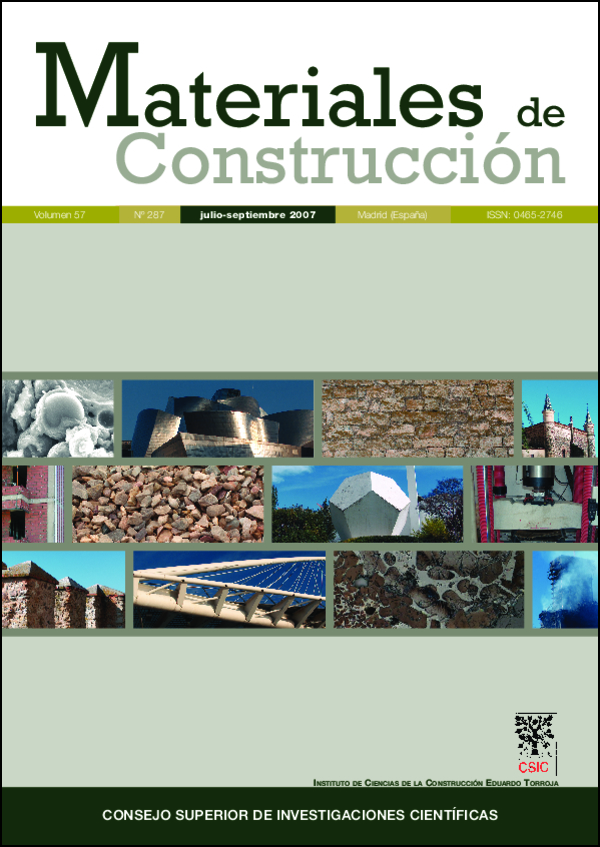Petrophysical characterization of three commercial varieties of miocene sandstones from the Ebro valley
DOI:
https://doi.org/10.3989/mc.2007.v57.i287.57Keywords:
sandstone, physical properties, durability, petrophysics, construction stoneAbstract
Miocene sandstones studied were used extensively to build Aragon’s architectural heritage, are still used in modern construction. The quarries presently located on the edge of the Ebro Valley depression. The present paper describes an exhaustive petrophysical study of these materials, which while, of the same age and from the same deposition basin, exhibit different mineralogical and textural characteristics and as a result, different physical and mechanical properties and durability. The petrographic and petrophysical characteristics of these materials were evaluated with tests prescribed in UNE (Spanish), NORMAL and ASTM standards. All the results were subjected to statistical analysis to identify possible textural and compositional nonuniformities in the material that may underlie behavioural changes.
The results of the present paper show that their petrophysical characteristics afford these sandstones substantial industrial value as construction materials. Durability was found to be longest in the Alcañiz stone, as a result of the geometry of its pore network.
Downloads
References
(1) Arenas, C.: Sedimentación y paleogeografía del Terciario del margen pirenaico y sector central de la cuenca del Ebro (zona aragonesa occidental), Tesis doctoral, Universidad de Zaragoza. Inédita (1993).
(2) Esbert, R., Marcos, R., Ordaz, J., Montoto, M., Suárez, L., Ruiz de Argandeña, V., Calleja, L., Alonso, F. J. y Rodríguez-Rey, A.: “Petrografía, propiedades físicas y durabilidad de algunas rocas utilizadas en el patrimonio monumental de Catalunya, España”, Mater. Construcc., vol. 39, nº 214 (1989), pp. 37-47.
(3) Andaluz, N., Gisbert, J., Marin, C. y Delgado, S.: “Propuesta de clasificación petrográfica de las areniscas terciarias del valle del Ebro”, Geogaceta, vol. 24 (1988), pp. 19-22.
(4) Andaluz, N., Marin, C., Gisbert, J. y Recuenco, J.: “Petrophysic of Tertiary sandstone in eastern Aragon (Ebro basin, Spain)”, Quarry - laboratory - monument, International congress-Pavia, 2000.
(5) Puigdefábregas, T.: La sedimentación molásica en la cuenca de Jaca, Monografías del Instituto de Estudios Pirenaicos, nº 104, 1975.
(6) Quitantes, J.: Estudio sedimentológico y estratigráfico del Terciario continental de los monegros, Institución Fernando el Católico, CSIC Zaragoza, 1978, p. 207.
(7) Poli, T., Toniolo, L. y Chiantore, O.: “The protection of different marbles with two partially fluorinated acrylic copolymers”, Materials Science & Processing, vol. 79, nº 2 (2004), pp. 347-351.
(8) Munsell: Munsell soil color charts, Munsell products, Baltimore, Maryland, 1976.
(9) Norma UNE 12372: “Métodos de ensayo para piedra natural. Determinación de la resistencia a la flexión bajo carga concentrada”, 1999.
(10) Norma UNE-EN 1926: “Métodos de ensayo para piedra natural. Determinación de la resistencia a la compresión”, 1999.
(11) Norma UNE-EN 1936: “Métodos de ensayo para piedra natural. Determinación de la densidad real y aparente y de la porosidad abierta y total”, 1999.
(12) Norma UNE-EN 1341: “Baldosas de piedra natural para uso como pavimento exterior. Requisitos y métodos de ensayo”.
(13) Norma UNE-EN 12407: “Métodos de ensayo para piedra natural. Estudio petrográfico”, 2001.
(14) Norma UNE-EN 13755: “Métodos de ensayo para piedra natural. Determinación de la absorción de agua a presión atmosférica”, 2002.
(15) Norma ASTM D 2240: “Standard Test Methods for rubber property - durometer hardness”, vol. 09.01 USA, 1992.
(16) Normal Comision 25-PEM Protección y erosión de monumentos: Ensayo nº II. Dilatación lineal por absorción de agua, 1980.
(17) Normal 11/85 oggetto- “assorbimento d’acqua per capillaritè – coefficiente di assorbimento capillare”, CNR-ICR, Roma.
(18) Schön, J. H.: Physical properties of rocks: Fundamentals and principles of petrophysics. Pergamon, Nueva York, 1996, p. 583.
(19) Norma UNE 67-028-97-EX.: “Ladrillos cerámicos de arcilla cocida. Ensayo de heladicidad”.
(20) Normal Comision 25-PEM Protección y erosión de monumentos: Ensayo nºV.b.: “Cristalización por inmersión total para piedra tratada”, 1980.
(21) Pettijohn, F. J., Potter, P. E. y Siever, R.: Sand and sandstone, Springer Verlag, New Cork, 1987, p. 553.
(22) Beard, D.C. y Weyl, P. K.: Diagenesis of sandstone, AAPG reprint series nº 20, 1997.
(23) Fort, R., Bernabéu, A., García del Cura, M. A., López de Azcona, M. C., Ordóñez, S. y Mingarro, F.: “La piedra de Novelda: una roca muy utilizada en el patrimonio arquitectónico”, Mater. Construcc. (2002), nº 266, pp. 19-33.
(24) ISRM: ISRM (Internacional Society for Rock Mechanics), 1981, en E. T. Brown (ed.): “ISRM Suggested method: Rock characterization, testing and monitoring”, Pergamon press, Londres.
(25) González Vallejo, L.: Ingeniería Geológica, Pearson Prentica Hall, 2003, p. 715.
(26) Buj, O. y Gisbert, J.: “Evaluation of three consildant in Miocene sandstones of the Ebro basin. Heritage, Weathering and conservation”, en R. Fort, M. Álvarez de Buergo, M. Gomez-Heras y C. Vazquez-Calvo (eds.): vol. 2, 2006, pp. 741-748.
Downloads
Published
How to Cite
Issue
Section
License
Copyright (c) 2007 Consejo Superior de Investigaciones Científicas (CSIC)

This work is licensed under a Creative Commons Attribution 4.0 International License.
© CSIC. Manuscripts published in both the print and online versions of this journal are the property of the Consejo Superior de Investigaciones Científicas, and quoting this source is a requirement for any partial or full reproduction.
All contents of this electronic edition, except where otherwise noted, are distributed under a Creative Commons Attribution 4.0 International (CC BY 4.0) licence. You may read the basic information and the legal text of the licence. The indication of the CC BY 4.0 licence must be expressly stated in this way when necessary.
Self-archiving in repositories, personal webpages or similar, of any version other than the final version of the work produced by the publisher, is not allowed.
















